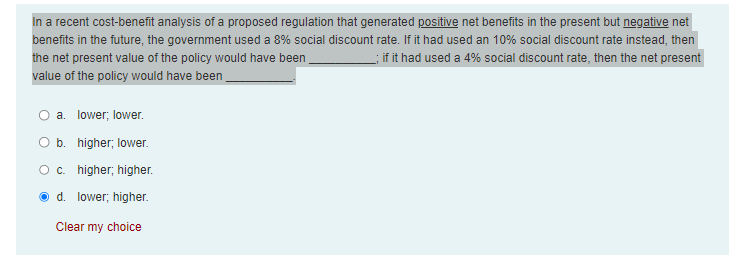In a recent cost-benefit analysis of a proposed regulation that generated positive net benefits in the present but negative net benefits in the future, the government used a 8% social discount rate. If it had used an 10% social discount rate instead, then the net present value of the policy would have been __; if it had used a 4% social discount rate, then the net present value of the policy would have been a. lower; lower. O b. higher; lower. O c. higher; higher. d. lower; higher. Clear my choice
In a recent cost-benefit analysis of a proposed regulation that generated positive net benefits in the present but negative net benefits in the future, the government used a 8% social discount rate. If it had used an 10% social discount rate instead, then the net present value of the policy would have been __; if it had used a 4% social discount rate, then the net present value of the policy would have been a. lower; lower. O b. higher; lower. O c. higher; higher. d. lower; higher. Clear my choice
Financial Reporting, Financial Statement Analysis and Valuation
8th Edition
ISBN:9781285190907
Author:James M. Wahlen, Stephen P. Baginski, Mark Bradshaw
Publisher:James M. Wahlen, Stephen P. Baginski, Mark Bradshaw
Chapter9: Operating Activities
Section: Chapter Questions
Problem 12QE
Related questions
Question
Note:-
Please avoid using ChatGPT and refrain from providing handwritten solutions; otherwise, I will definitely give a downvote. Also, be mindful of plagiarism.
Answer completely and accurate answer.
Rest assured, you will receive an upvote if the answer is accurate.

Transcribed Image Text:In a recent cost-benefit analysis of a proposed regulation that generated positive net benefits in the present but negative net
benefits in the future, the government used a 8% social discount rate. If it had used an 10% social discount rate instead, then
the net present value of the policy would have been
__; if it had used a 4% social discount rate, then the net present
value of the policy would have been
a. lower; lower.
O b. higher; lower.
O c. higher; higher.
d. lower; higher.
Clear my choice
Expert Solution
This question has been solved!
Explore an expertly crafted, step-by-step solution for a thorough understanding of key concepts.
This is a popular solution!
Trending now
This is a popular solution!
Step by step
Solved in 3 steps

Knowledge Booster
Learn more about
Need a deep-dive on the concept behind this application? Look no further. Learn more about this topic, finance and related others by exploring similar questions and additional content below.Recommended textbooks for you

Financial Reporting, Financial Statement Analysis…
Finance
ISBN:
9781285190907
Author:
James M. Wahlen, Stephen P. Baginski, Mark Bradshaw
Publisher:
Cengage Learning

Essentials of Business Analytics (MindTap Course …
Statistics
ISBN:
9781305627734
Author:
Jeffrey D. Camm, James J. Cochran, Michael J. Fry, Jeffrey W. Ohlmann, David R. Anderson
Publisher:
Cengage Learning


Financial Reporting, Financial Statement Analysis…
Finance
ISBN:
9781285190907
Author:
James M. Wahlen, Stephen P. Baginski, Mark Bradshaw
Publisher:
Cengage Learning

Essentials of Business Analytics (MindTap Course …
Statistics
ISBN:
9781305627734
Author:
Jeffrey D. Camm, James J. Cochran, Michael J. Fry, Jeffrey W. Ohlmann, David R. Anderson
Publisher:
Cengage Learning


Intermediate Financial Management (MindTap Course…
Finance
ISBN:
9781337395083
Author:
Eugene F. Brigham, Phillip R. Daves
Publisher:
Cengage Learning